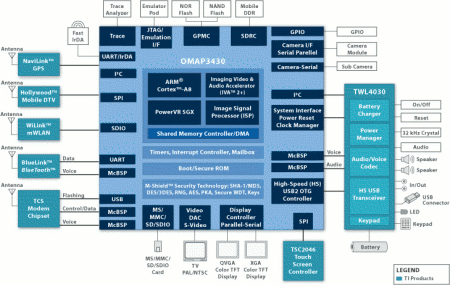Linux phone stacks target Cortex-A8 SoC
Jun 4, 2008 — by Eric Brown — from the LinuxDevices Archive — 2 views Two vendors of Linux mobile phone software announced support for Texas Instruments's newest applications processor for mobile phones. At Computex Taipei, Movial Creative Technologies is showing its IXS (Internet eXperience Stack) mobile toolkit, and Azingo is demonstrating its… Azingo Mobile stack, both optimized for TI's OMAP3430.
Two vendors of Linux mobile phone software announced support for Texas Instruments's newest applications processor for mobile phones. At Computex Taipei, Movial Creative Technologies is showing its IXS (Internet eXperience Stack) mobile toolkit, and Azingo is demonstrating its… Azingo Mobile stack, both optimized for TI's OMAP3430.
Clockable to 800MHz, the OMAP3430 is among the first SoCs based on ARM's Cortex-A8 architecture. Cortex-A8 is positioned as burning similar power to ARM11, while delivering two-to-three times better performance.
Azingo Mobile
Azingo announced its planned integration with TI OMAP3430 in February. At the Computex show in Taipei, Taiwan, this week, Azingo will demonstrate a LiMo-compatible integration of Azingo Mobile (pictured at top) optimized for the OMAP3430. The demo reportedly includes “touchscreen Internet browsing, web widget applications, audio, video, and personalized user applications,” says Azingo. In addition, Azingo says it is now a member of the TI Developer Network.
Movial IXS Toolkit
Movial's Movial IXS Toolkit is a “white label application suite for creating custom branded user interfaces,” says the Finland-based company. Movial's IXS consists of a browser, a media player, and a Communicator suite of video telephony, presence, instant messaging, and video-sharing software. The software “allows Web developers and designers to rapidly create mobile device user interfaces using common Web-based technologies, including Web 2.0, Ajax JavaScript, and XML,” says Movial.
In February, MontaVista and Movial announced they would jointly integrate, market, and support MontaVista's Mobilinux OS and DevRocket development tools with IXS. Movial is known for originating the popular scratchbox embedded development tool. The company assists consumer electronics companies in creating Linux devices, especially SIP-, OMA-, and XMPP-connected devices based on the GTK or Qt graphics frameworks. Key clients include HP, Orange and Telefonica, and Nokia, according to the company.
TI's popular mobile SoC
The OMAP3430 has garnered considerable hardware and software support over the last year, including:
- In 2007 Access announced it was supporting the SoC in its ALP phone stack.
- Last year, the processor was designed into an Ericsson mobile phone reference design.
- In January of this year, OpenPandora.org announced that its Linux-based portable gaming device, Pandora, was using the processor.
- In February Aricent announced audio and video codecs aimed at letting phones based on the OMAP3430 play and record high-definition (HD) video in MPEG-4 format.
- Also in February, Wind River demonstrated its Consumer Devices Linux kernel and Google's Android stack the SoC.
- In April, MontaVista announced that its Mobilinux distribution would support the SoC.

OMAP3430 architecture
(Click to enlarge)
Stated Mahesh Veerina, Azingo CEO, “We're very pleased to deliver a LiMo-based mobile Linux solution for OMAP technology customers following so quickly on the heels of TI's membership in the LiMo Foundation.”
Stated Tomi Rauste, president of Movial Creative Technologies, “Movial IXS Toolkit enables extremely fast and cost-efficient user interface development based on the TI OMAP3430 solution.”
Availability
Neither Azingo or Movial announced final availability of their OMAP3430-integrated products, but Azingo will demonstrate the integration in the TI's briefing suite, and Movial will show its integration at an undisclosed location at Computex this week. More information on TI's OMAP processors may be found here.
While the 3430 is primarily targeted at handset vendors, TI also offers a similar OMAP3440 processor designed for a wider audience of low-volume embedded customers.
This article was originally published on LinuxDevices.com and has been donated to the open source community by QuinStreet Inc. Please visit LinuxToday.com for up-to-date news and articles about Linux and open source.